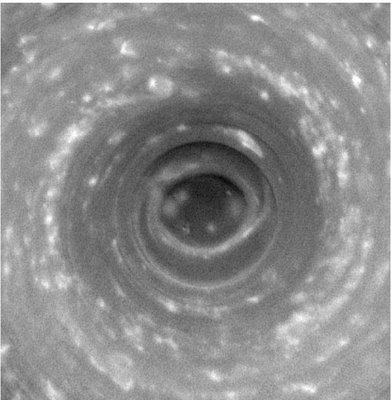The Great Cyclone of Saturn

You may recall my predicting that there is more going on in Saturn than meets the eye. Cassini sends us this picture of a cyclone (hurricane) fixed on Saturn's South Pole. From observations with our Subaru telescope, colleagues have determined that the South Pole is the warmest region of the surface. The storm is 8000 kilometres across!
My mother told stories of Pacific cyclones, which make a Kansas tornado look small. In our P-3 aircraft, we have studied cyclones up close. Forming an cyclone requires a source of warm gas. Like its little moon Enceladus, Saturn has a jet of hot particles from its core. This is exactly what we would see from an internal singularity. Among the planets, Saturn is unusual in that its magnetic poles are aligned with the geographic poles. The magnetic field behaves like a dipole with the "positive" pole in the South.
Heat in the core breaks hydrogen atoms down into electrons and positively charged ions, which spiral along magnetic field lines to form jets. The northern jet is composed of electrons which are absorbed by Saturn's interior. The southern jet is composed of more energetic ions which penetrate these layers to warm the South Pole. This is one more bit of evidence that planets are formed around internal singularities.
The Hubble and Spitzer Space Telescopes combined to create this image of the Orion Nebula. Green indicates UV and visible light images from Hubble, while reds and oranges are infrared from Spitzer. In the centre are 4 massive stars each with 100,000 times the mass of our sun. You can see this nebula tonight in the constellation Orion.



2 Comments:
We live in a beautiful solar system. Louise, did CV predict the storm?
Hee hee, when has CV predicted anything? Some days I just feel sorry for those guys.
Post a Comment
<< Home